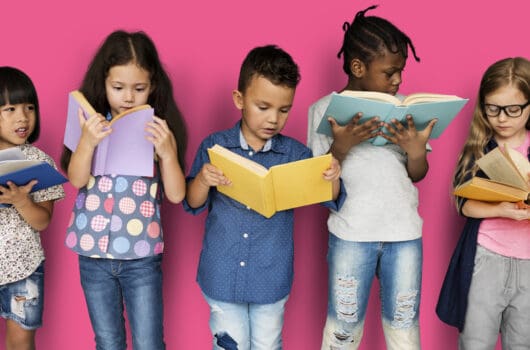Seven can be a very tricky age for finding books. Reading is still very new to 7-year-olds and this age group can show significant diversity in skill level, with some 7-year-olds already devouring chapter books while others still struggle with sounding out words in picture books.
In this guide, you’ll find tips on how to find good books for 7-year-olds, what reading skills a 7-year-old should have, and a list of the best books for 7-year-olds.
Because of the diversity in skill level at this age, we’ve included a wide range of book options in our list, including picture books, beginner chapter books, and a few more advanced chapter books.
- What Are Good 7-Year-Old Books?
- Top 16 Best Books for 7-Year-Olds 2025
- 1. Best Overall Book: Magic Tree House Boxed Set
- 2. Best Beginner’s Chapter Book: Zoey and Sassafras: Dragons and Marshmallows
- 3. Best Premium Book: Where the Sidewalk Ends
- 4. Best Picture Book: Ada Twist, Scientist
- 5. Best Book About Confronting your Fears: Jabari Jumps
- 6. Best Budget Book: My Big Fat Zombie Goldfish Boxed Set
- 7. Best Book for Budding Book Lovers: The Word Collector
- 8. Best Book About Self-Acceptance: The Bad Seed
- 9. Best Time Travel Book: The Secret Lake
- 10. Best Book for the Whole Family: The Gruffalo
- 11. Best Book for Advanced Readers: Howl’s Moving Castle
- 12. Best Classic Book: Dr. Seuss’s Beginner Book Collection
- 13. Best Book for Foundational Reading Skills: First Little Reader’s Parent Pack
- 14. The Never Girls Collection
- 15. Junie B Jones First Boxed Set Ever
- 16. Best Series: Captain Underpants 10 Book Set
- Final Thoughts on Books for 7-Year-Olds
What Are Good 7-Year-Old Books?
Choosing a good book for a 7-year-old largely comes down to their reading skills. More advanced readers will be ready for full chapter books. 7-year-olds who still need to build up some fundamental skills might benefit more from picture books.
Children who are somewhere in between will enjoy beginner’s chapter books. These feature full paragraphs of text alongside pictures that help demonstrate the meaning of what they are reading.
Reading Skills at Age 7
Before you shop for books, take a look at the specific reading skills your 7-year-old is learning in school. Identify the ones that you know your child is best at and the ones that they may need more work on.
Skills Your 7-Year-Old May Already Have
Over the last couple of years, many children to sound out the letters of the alphabet and started working on putting those letters together to form words. The typical 7-year-old should know basic spelling rules and be able to sound out most common words rather than the individual letter groups, they should understand the words that they’re reading (and know what to do when they don’t), and they should be able to connect what they read with the real word—and other books.
Not all 7-year-olds are at this level, though, and that’s fine. If your little one hasn’t mastered these skills, we’ve still included some accessible books that should get them there in no time.
Skills Your 7-Year-Old Will Need by Third Grade
When your child enters third grade, they will shift from getting active lessons in reading skills to now applying the reading skills they learned before to other subjects. In other words, until now, your child has been learning to read. In 3rd grade, they will instead be reading to learn.
This is the last year when they will get active lessons in how to read. It’s important to do what you can now to make sure they are comfortable and confident with all the reading skills mentioned above. Below, we’ll discuss what skills your child should be focusing on to prepare for next year and give you a few tips for how parents can help build these reading skills.
Reading Comprehension
This is the most important skill you’ll want to help your child develop. This is the ability to not just correctly sound out or identify a word but to comprehend the information or story that is being told in the book. It’s far better to have a child who reads slowly but comprehends everything than a child who speeds through sentences without taking the time to absorb the information.
Make sure that you spend plenty of time reading together with your child. Whether they read to you or you read to them, make sure that you ask lots of questions about the story to ensure that you’re following along and not just reading the words—both while you’re reading and after you finish the book.
This routine will help them with their comprehension, memory, and recall so that they can enter third grade with a strong ability to learn and retain the information they read. It will also start developing their ability to cite evidence from a text when discussing or writing about it later, a skill they will need when they are a few years older.
Multi-Syllable Words
From third grade on, your child is going to be exposed to increasingly longer and more complicated words. The ability to instinctively identify where the syllable breaks occur and how to read longer words aloud will make them much more confident readers.
Without this skill, studying and completing homework will be a slow and frustrating process for your child who still has to slowly sound out letters and go over longer words multiple times to figure out what it is.
When you are reading to your child, read slowly and follow the words with your finger, pausing on each syllable. This will help visually represent where syllable breaks happen in longer words and prepare your child to instinctively breakdown multi-syllable words quickly and accurately for easier reading.
Making Inferences
This is the ability to draw conclusions or make accurate assumptions that aren’t directly stated in the text. If a character devours the lasagna on their plate but only pokes at the broccoli with their fork, a reader might infer that the character doesn’t like broccoli even though it’s never directly stated.
As a parent, you can help with this skill by asking inference questions about the characters and events in the story. Ask them about how the characters feel and what they think they’ll do next. Teach them to understand cause and effect.
Studies show that asking inferencing questions to your child as you read together will not only improve the skill but also lead to them habitually making more inferences as they read other books on their own. This is a sign of active reading and processing of information.
Use Prefixes and Suffixes to Understand New Words
In third grade, they’ll start learning about prefixes and suffixes. These simple grammatical tools are important for quickly figuring out the meaning of a word, even if they’ve never seen it before. If they know what “help” means and they know what the suffix “-less” indicates, then they can quickly guess what “helpless” means even if they’ve never seen the word before.
As a parent, you can help with this by pointing out easy examples of these root and affix combinations when you read with your child. Avoid pointing out any examples where the root of the word isn’t that clear. For example, words like “portable” where your child might not yet know that “port” means to carry.
With these reading skills and tips in mind, take a look at our top books for 7-year-olds for 2025. For each book, we’ll provide a handy list of the skills your child should already have in order to read it and a list of the skills that it will help your child develop.
Top 16 Best Books for 7-Year-Olds 2025
1. Best Overall Book: Magic Tree House Boxed Set

Editor’s Rating:
Quick Facts:
- Chapter Book
- Skills Required:
- Spelling rules and phonetics
- Self-monitoring
- Reading fluency
- Skills Developed:
- Drawing connections
- Making inferences
- Reading comprehension
This classic series of time travel features two children who get to go on crazy adventures that will fascinate your 7-year-old. These books are a great way to help them develop independent reading skills while also fostering a love of learning and discovering new things about the world.
Summary
The Magic Tree House series follows brother and sister duo, Jack and Annie. They’re two regular kids who end up discovering a treehouse in the woods. This treehouse has the ability to transport them through time. In each book, they go on a different adventure through time.
In the first book, they go back to the age of dinosaurs. Next, they’re wandering through medieval castles. Then, they’re exploring the ancient Egyptian pyramids. It’s an exciting series full of adventure that manages to sneak in a little educational content at the same time.
Skill Focus
This is a great series for improving your child’s ability to draw connections and make inferences. The places and time periods Jack and Annie explore are usually ones that your child will have learned about or seen in other stories. This book will help them recall what they have learned and build on it throughout the series.
One of the great things about the Magic Tree House series is that it grows with your child. There are two reading levels built into the series. For children ages 6-9, the Magic Tree House books here are perfectly tailored to their reading level.
When your child gets older, they can switch to the more advanced Merlin Missions books. It’s all part of the same series your child has grown to love but written at a more advanced level, appropriate for ages 7-10. In fact if your 7-year-old is a more advanced reader, they might enjoy the Merlin Mission books now.
For children who are a little behind their peers, especially on reading fluency or phonetics, these chapter books might be a little too advanced for them. A picture book like The Gruffalo might be a better choice to help bring their skills up to speed.
Pros
- Series offers tiered reading levels to help your child develop skills naturally
- Great for developing connection and inference skills
- Excellent first chapter book
- Long series ensures plenty of reading material
Cons
- Chapter books are too advanced for some new readers
2. Best Beginner’s Chapter Book: Zoey and Sassafras: Dragons and Marshmallows
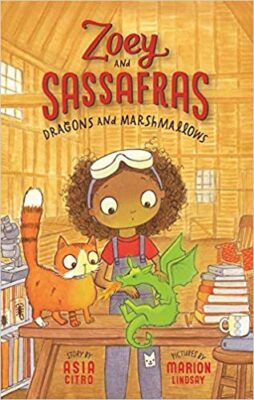
Editor’s Rating:
Quick Facts:
- Beginner’s Chapter Book
- Skills Required:
- Spelling rules and phonetics
- Skills Developed:
- Making inferences
- Vocabulary
- Draw connections
This tale of adventure and mystery is filled with creatures both mythical and real. Just like the creatures, the adventures themselves are equal parts magical and scientific, making this book a fascinating yet educational story that children will love.
Summary
When a sick baby dragon named Marshmallow shows up in her backyard, it’s up to Zoey and her cat sidekick, Sassafras, to figure out what’s wrong and help save the baby dragon. To do so, they conduct real scientific experiments and research to solve the mystery and save the day.
Skill Focus
Some of the experiments that Zoey does in the story are easy to replicate at home, so you can help your children to try out the same experiments themselves. This will allow them to draw connections between the book and their own attempts while also inspiring a love of science!
Each book in the Zoey and Sassafras series comes with a kid-friendly glossary in the back that defines the scientific terms and bigger words that are used. This makes it a uniquely great opportunity to expand your child’s vocabulary with words that will help them in school.
It’s also a fun way to work on your child’s inferencing skills. As Zoey conducts experiments, you can ask your child what they think the results will be. As she gathers more clues about the mystery, ask your child to make predictions about what they think the solution is.
As fascinating as the story is, it is definitely written for simplicity. More advanced readers might not find the writing style challenging enough to help them develop new reading skills. For something better suited to more advanced readers, you might try The Secret Lake.
Pros
- Kid-friendly scientific glossary in the back
- Educational and fun story that blends magic and science
- Great for developing vocabulary and inference skills
Cons
- Writing style might be too simple for more advanced readers
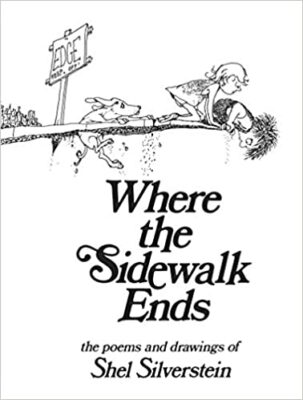
Editor’s Rating:
Quick Facts:
- Poetry Collection
- Skills Required:
- Basic spelling rules and phonetics
- Skills Developed:
- Spelling rules and phonetics
- Reading fluency
- Vocabulary
The author, Shel Silverstein, is a children’s classic who’s written many incredible poetry collections, including Where the Sidewalk Ends. His poems are accessible, engaging, and a great way to develop phonetic skills and reading fluency.
Summary
This book features 130 poems that are funny, heartfelt, and fully in tune with a child’s mindset. From building a boat with no bottom to eating a whole week of food in one meal, each poem deals with a subject that is funny and completely child-friendly.
While all the poems are written with a child-like perspective, sometimes that perspective is a little bit cynical. For example, there’s a poem about a kid trying to sell his annoying sister to anyone who will take her. These are meant to just be funny and lighthearted, but some parents find them inappropriate. If you’d prefer a book without any cynical moments, check out The Word Collector instead.
Skill Focus
The accessible language is perfectly suited to a new reader, while the rhyming lines and the fun illustrations provide helpful clues for sounding out the words and figuring out what they mean. These poems will sharpen the fundamental skills your child needs to be a great reader.
Pros
- 130 funny and engaging poems
- Great for new readers
- Helps improve phonetics and reading fluency
Cons
- A few of the poems have mildly cynical themes
4. Best Picture Book: Ada Twist, Scientist
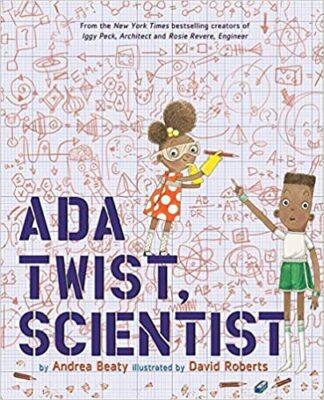
Editor’s Rating:
Quick Facts:
- Picture Book
- Skills Required:
- Basic spelling and phonetics
- Skills Developed
- Spelling and phonetics
- Reading speed and fluency
- Making inferences
Ada Twist, Scientist is the first in a series of books about Ada, a second-grade scientist with a tireless drive to discover. If your kids like Ada, they’ll also like Ada’s friends who all star in their own book series. There are a lot more books like this if your 7-year-old takes to them, so you’ll be able to keep the momentum going.
Summary
Ada Twist is a second-grade scientist with a never-ending sense of curiosity and a love of conducting experiments, even if many of those experiments end up wreaking havoc. Whether she’s trying to wash the family cat in the washing machine or plot out her scientific hypotheses on the living room wall, children will find Ada Twist equal parts hilarious and inspiring.
Some parents find that this book falls short of driving home the theme that curiosity and an urge to discover are good but need to be applied in controlled experiments. Most of Ada’s attempts at experimentation here are interrupted by the adult characters who are trying to stop her or put her on time out.
Fortunately, Ada Twist appears in multiple sequels that help reinforce the more inspiring message this story is meant to have. But this first book on its own might feel unfinished or even discouraging. For a more cohesive and uplifting standalone book, you might prefer Jabari Jumps.
Skill Focus
The memorable rhyme scheme of the narrative helps with sounding out words so if your child is still working on phonetics and reading speed, this is a good pick to help develop those skills. The vocabulary is perfect for a 7-year-old and the themes of scientific discovery will inspire them to persevere even when it gets difficult.
Pros
- Great for strengthening fundamentals like phonetics and reading speed
- Nurtures a love for STEM subjects
- Part of a series
Cons
- Potentially discouraging ending if not read with its sequels
5. Best Book About Confronting your Fears: Jabari Jumps
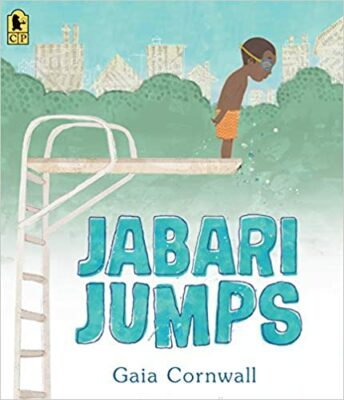
Editor’s Rating:
Quick Facts:
- Picture Book
- Skills Required:
- Spelling and phonetics
- Skills Developed:
- Making inferences
- Reading speed and fluency
Jabari Jumps is the first in a series of books about Jabari learning to be brave and try new things. He’s an inspiring character and a great role model for young children. The books themselves are also useful for developing reading skills.
Summary
After finishing his lessons and passing his swim test, Jabari is ready for the final challenge: jumping off the high dive. At first, he’s undaunted. It looks easy and he’s already a good jumper. However, as his turn on the diving board gets closer, he gets scared and starts making excuses to avoid it.
It’s a story of confronting your fears and finding the courage to challenge yourself, even when it’s scary. For parents who want a book that teaches great life lessons, this is the one to get. Jabari is a relatable character who ultimately learns the value of perseverance and bravery.
Skill Focus
Picture books are a helpful way to build strong reading foundations. The illustrations provide important visual cues about the story to help the child decode the meaning of what they’re reading. The narrative of this book will also help develop early inference making skills. There are a few opportunities for inferring how Jabari is feeling and what the cause of his emotions are.
Despite being a picture book and a child-oriented story, some of the language might be a little hard for children who are still learning the fundamentals. Words with tricky letter combinations and sounds, like “edge” and “climb” do appear and these might be challenging for some new readers. You may have to read this one with your children a few times to help them.
For a picture book that’s easier for new readers to read on their own, try the First Little Readers.
Pros
- Inspiring message of overcoming fear
- Great for strengthening fundamental reading skills
- Helps develop early inferencing skills
Cons
- Writing style may be too difficult for readers who are still learning fundamentals
6. Best Budget Book: My Big Fat Zombie Goldfish Boxed Set
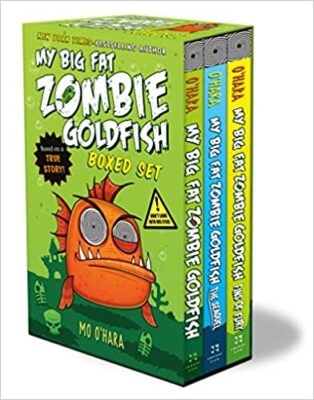
Editor’s Rating:
Quick Facts:
- Chapter Book Series
- Skills Required:
- Spelling rules and phonetics
- Basic reading comprehension
- Reading fluency
- Skills Developed:
- Reading comprehension
- Making inferences
- Drawing connections
With three full-length chapter books in one, this affordably priced set is a cost-effective way to start getting your child to enjoy reading just for fun. The story of a zombie goldfish with super powers couldn’t get any further from “boring school stuff.” Your 7-year-old will finally be convinced that books can be just as weird and wacky as their own imagination.
Summary
When Tom’s goldfish dies, he suddenly gets the idea to try to zap it back to life with a battery. To his surprise, it actually works. Frankie the goldfish comes back to life, this time with the power of hypnosis.
Together, Tom and his zombie goldfish take on evil scientists, battle electric eels, and encounter other paranormal pets. It’s funny and fast-paced. It’s exactly the kind of story a 7-year-old will want to read.
Skill Focus
These beginner’s chapter books are a great way to transition your child from picture books to full chapter books. If you find that they are getting bored by their picture books, it may be time to give them something a little more challenging. These books are a great pick for that.
With all the crazy adventures, you can ask lots of reading comprehension and inferencing questions as your child reads to help them develop the more advanced reading skills they’re going to need next year.
Some children, especially those with dyslexia or a similar disability, might find the tightly spaced lines and the print difficult to read. For a book with larger, more reader-friendly print, try Junie B. Jones.
Pros
- Great for sparking a love of reading
- Helps build advanced reading skills
- Opportunities to ask reading comprehension and inferencing questions
Cons
- Lines are tightly spaced
7. Best Book for Budding Book Lovers: The Word Collector

Editor’s Rating:
Quick Facts:
- Picture Book
- Skills Required:
- Basic spelling and phonetics
- Skills Developed:
- Reading speed and fluency
- Vocabulary
Jerome is a young boy learning to read, just like many of the readers this book was written for. The narrative helps reframe the sometimes frustrating experience of encountering words you don’t know. Instead of being frustrated, Jerome loves finding and learning new words for the first time.
Summary
In Word Collector, Jerome is a little boy with a passion for discovering new words. Every time he hears a new one, he writes it down and adds it to his collection. This heartwarming story inspires a love of words and will give your kids the motivation they need to approach learning to read like an adventure rather than a chore.
Skill Focus
It’s no surprise that a story about a boy who collects words will help your child build their vocabulary. Not only will they learn new words in this book, they may also become inspired to be a “word collector” themselves. This curiosity to collect and learn new words will help them in every school subject.
Despite the inspiring message and the wealth of new words your child will encounter, some parents and teachers have noted that the book is a little sparse on detail. Not as much space is given to definitions or examples of word usage. It’s definitely more geared toward nurturing a love for language rather than directly teaching readers new words.
For a book that better balances education with inspiration, you might try Zoey and Sassafras.
Pros
- Makes learning to read an adventure
- Great pick for expanding vocabulary
- Develops fundamental reading skills
Cons
- Misses some educational opportunities
8. Best Book About Self-Acceptance: The Bad Seed
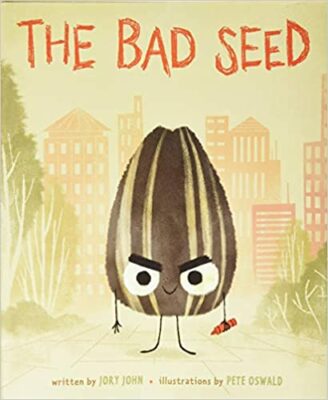
Editor’s Rating:
Quick Facts:
- Skills Required
- Spelling rules and phonetics
- Skills Developed
- Reading speed and fluency
- Reading comprehension
- Drawing connections
- Picture book
This book about a seed gone bad teaches kids about manners and the importance of being kind to each other. It does so with beautiful illustrations that help early readers decode the meaning of the words they’re reading.
Summary
In a world populated by different kinds of seeds, the main character of this book is one bad seed. He tells bad jokes. He lies. He doesn’t clean up after himself. As you keep reading, you find out that he didn’t start out so bad. He used to be a good seed—but after a bad experience that he didn’t handle very well, he went bad.
It’s a story meant to open up a dialogue with your child about the consequences of bad behavior and how to deal with bad experiences in a healthier way, without becoming a “bad seed.” It can also be used to start a dialogue about how to be more empathetic toward others who might not be “bad seeds” but just regular people having a bad day.
As positive as the messaging is, some parents find that the ending is a little ambiguous. The bad seed doesn’t become a completely good seed. He still makes mistakes and is more of a “work in progress” by the end. While this was an intentional choice by the author, it might be a little too nuanced for some young children.
For a book with a more clear and easy to grasp message, you might prefer Ada Twist, Scientist.
Skill Focus
In addition to social skills like empathy and understanding, this picture book will help your child develop a strong foundation of fundamental reading skills. The vivid illustrations pair with simple, easy-to-read sentences, featuring words that your 7-year-old is likely to know.
Pros
- Great for developing emotional intelligence and empathy
- Helps build fundamental reading skills
- Beautiful illustrations
Cons
- Somewhat ambiguous ending
9. Best Time Travel Book: The Secret Lake
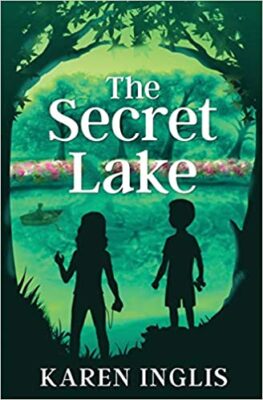
Editor’s Rating:
Quick Facts:
- Chapter Book
- Skills Required
- Spelling rules and phonetics
- Reading speed and fluency
- Basic reading comprehension
- Skills Developed
- Reading comprehension
- Making inferences
- Drawing connections
The Secret Lake is a mysterious story filled with time travel and strange characters. The main characters explore the connections between the past and present as they try to solve the mystery. Your little reader won’t want to put it down until they get to the end.
Summary
Stella and Tom are siblings who move to a new home in London. Shortly after arriving, their neighbor’s dog disappears. When it suddenly comes back, it’s soaking wet. The siblings go on a quest to figure out where the dog keeps disappearing to.
Along the way, they discover a tunnel that goes through time and a mysterious secret lake. The mysteries just keep piling on the more they explore these hidden areas around their new home.
This is a wonderful pick to foster a love of more advanced literature. Unlike most children’s books that are largely plot-driven, this story is full of atmosphere and mystery. The vivid descriptions create an immersive experience that help bring the world of the book alive. This will prepare them to enjoy more advanced books that take more time to set up rich, fully built worlds.
With that in mind, it is a more advanced children’s book. Its target age group is 8-11, which means it’s better suited to advanced 7-year-olds. If your child is still struggling with the basics, this may be too challenging. A beginner’s chapter book like the Magic Tree House series might be a better place to start.
Skill Focus
This mysterious and fascinating tale is great for developing strong reading comprehension and inference skills. As your child reads through the mystery, ask them questions about what they think will happen next and what they think the answer is to every new riddle that pops up as these siblings explore.
Pros
- Great introduction to more advanced reading
- Develops strong reading comprehension and inference skills
- Beautiful, atmospheric storytelling
- Exciting mysteries and riddles to keep your child engaged
Cons
- May be too advanced for some new readers
10. Best Book for the Whole Family: The Gruffalo
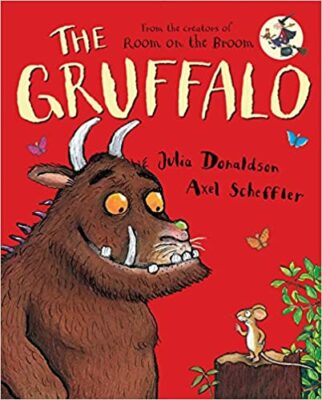
Editor’s Rating:
Quick Facts:
- Picture Book
- Skills Required
- Basic spelling rules and phonetics
- Skills Developed
- Reading speed and fluency
- Making inferences
It’s a fun story to read together and a great pick for the new reader who is just starting to read books on their own. This charming story has also been made into a short film available for streaming so you and your child can enjoy it in multiple formats.
Summary
The story follows a little mouse, the favorite prey of many predators including the owl, the fox, and the snake. In an effort to avoid being eaten, the mouse makes up a mythical beast, the Gruffalo, to scare these predators away. All goes according to plan until it turns out this Gruffalo is actually real.
It’s a fun story and the key to its charm lies in how it’s told. Adults and children alike love the rhythm and sound of the narrative as much as what’s happening in the story itself. However, this version has been Americanized, changing some of the rhymes and phrases. Long-time fans of the original Gruffalo, which was written in a Scottish dialect, find these changes to the text disappointing. If you want the original, you’ll need to order a different version.
Skill Focus
The exceptional rhyming and overall structure of the narrative itself make it a great tool for improving reading speed and fluency. There’s a good rhythm to it that will help kids anticipate the proper pronunciation of the words and even the proper stressing of syllables. For kids who need to strengthen their ability to read words without sounding out their letters first, this is a great choice.
Pros
- Memorable and enjoyable narrative
- Rhyme scheme and rhythm help kids improve reading fluency and speed
- Has been adapted into a short film
Cons
- The text in this version has been altered from the original Scottish
11. Best Book for Advanced Readers: Howl’s Moving Castle
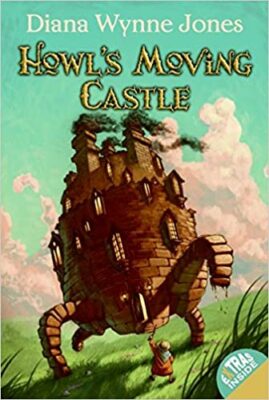
Editor’s Rating:
Quick Facts:
- Chapter Book
- Skills Required:
- Spelling rules and phonetics
- Reading speed and fluency
- Basic Reading comprehension
- Skills Developed:
- Reading comprehension
- Making inferences
Howl’s Moving Castle is now a popular animated movie that children everywhere have grown to love. Before it was a movie, it was an equally beloved fantasy trilogy filled with witches, wizards, and terrible curses. It makes a great first “real” chapter book for your new reader.
Summary
In this first book of the Howl trilogy, readers meet Sophie, the eldest of three girls who has been cursed by the Witch of the Waste to be transformed into an old lady. To break the curse, Sophie embarks on an epic hero’s journey to find the grand wizard, Howl, and his moving castle.
On the way, she has to strike a deal with a fire demon and ultimately confront the Witch of the Waste. It’s an exciting story that will have your child on the edge of their seat through the whole series.
Skill Focus
The Howl series will hone your child’s reading skills and inspire a love of reading. The story is written at a language level that children can easily understand. It also offers a story that is just complex enough to provide a new challenge to your little reader.
This book is written at a middle-grade level, intended for older children between 8-10. If your 7-year-old is already able to breeze through picture books and simpler chapter books on their own, this may be a great next step.
However, for children who are still working on those fundamental skills, this might be too difficult. Instead, a more beginner-friendly chapter book like Captain Underpants might be better.
Pros
- Part of a trilogy
- Great for developing advanced reading skills
- Exciting story with complex characters written in an accessible style
Cons
- Reading level may be too advanced
12. Best Classic Book: Dr. Seuss’s Beginner Book Collection
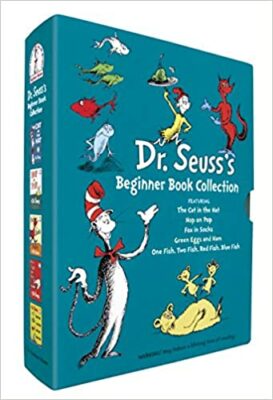
Editor’s Rating:
Quick Facts:
- Skills Required
- Basic spelling rules and phonetics
- Skills Developed
- Spelling rules and phonetics
- Reading speed and fluency
- Picture book
Dr. Seuss is a classic that many will remember from their own childhood. This set includes some of his greatest hits: Cat in the Hat, Green Eggs and Ham, Fox in Socks, and more. The charming rhymes and the relatable stories are what helped these books remain just as popular today as they were when Theodore Geisel first wrote them decades ago.
Summary
This set features five of Dr. Seuss’s most popular books:
- The Cat in the Hat
- Hop on Pop
- Green Eggs and Ham
- Fox in Socks
- One Fish, Two Fish, Red Fish, Blue Fish
With this collection, you can introduce your child to these memorable characters and foster their love of reading. If they love this set, there are other sets of Dr. Seuss books you can get to expand the collection and keep your child’s reading momentum going—including the aptly-named Dr. Seuss’s Second Beginner Book Collection, which includes a sequal to The Cat in the Hat and four other books.
Skill Focus
These books feature fun stories written in an accessible style, so they’ll be a great set to use as your child’s first independent reading. The simple language and the use of repetition and rhyming help build those fundamental reading skills like phonetics and reading fluency.
As wonderful as the stories are, you might be disappointed in the box this set comes in. It’s made of thin cardboard that will tear easily and doesn’t really add any impressive decoration to your bookshelf.
If you’re mainly buying this for the books themselves and plan to toss the box, this won’t be a big issue. However, if you want something that will also add to the aesthetic of your bookshelf, you might be disappointed in this collection.
For a higher quality and more visually appealing option, consider Where the Sidewalk Ends.
Pros
- Set includes many of Dr. Seuss’s greatest hits
- Repetition and rhyming help children develop fundamental reading skills
- Good choice to be the first books your children reads all by themselves
Cons
- Set comes in a flimsy box that will damage easily
13. Best Book for Foundational Reading Skills: First Little Reader’s Parent Pack

Editor’s Rating:
Quick Facts:
- Picture Book
- Skills Required:
- Basic spelling rules and phonetics
- Skills Developed:
- Spelling rules and phonetics
- Reading speed and fluency
The First Little Readers series was designed by educational professionals to help kids practice the fundamental reading skills they are learning in school. This set of level A books gives your child 25 books to help strengthen their grasp of spelling and phonetics while also improving their speed and fluency.
Summary
The set includes 25 short books that are light on plot or character development. These are mainly designed to be tools for teaching your child to read. So, it’s more geared toward exposing your child to the appropriate vocabulary for their reading level.
As a result, the actual stories being told are not all that impressive. For example, the book “What Is Red?” just features various characters identifying things that are red. Many of the books are similarly simplistic.
If you are struggling to get your child to sit down and focus on learning to read, these overly simplified narratives might not be engaging enough to hold their attention. For a book that can also help build fundamental reading skills but with more interesting stories, consider the Dr. Seuss set.
Skill Focus
Skill development is the key reason to get these books. They have been carefully constructed to be the perfect balance of accessible and challenging for the reading level they were designed for. This set features “Level A” books.
When your child is confidently reading through all of these, you can get them the Level B and then the Level C set. Each book will line up very well with the reading lessons your 7-year-old is getting in school so it’s a great way to give them some extra practice on the skills they are learning.
Pros
- Great practice for fundamental reading skills
- Set includes 25 books
- First Little Readers series comes in 8 levels
Cons
- Not very exciting narratives
14. The Never Girls Collection
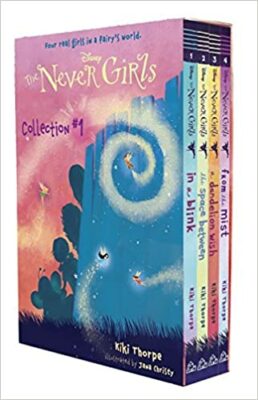
Editor’s Rating:
Quick Facts:
- Chapter Book Series
- Skills Required
- Spelling rules and phonetics
- Reading speed and fluency
- Skills Developed
- Reading comprehension
- Making inferences
- Drawing connections
This story about four best friends who go to Never Land is geared toward readers between the ages of 6 and 10. For any child who’s ever wished they could explore the fictional word of their favorite story, this series will be a dream come true.
Summary
In Never Girls, four best friends who wished they could go to Never Land for real are suddenly whisked off to this famous home of Peter Pan, Tinker Bell, and other childhood favorites. Throughout the four books collected in this set, the friends go on magical adventures that every reader will wish they, too, could go on.
For those who still want more of the story, there’s a total of 13 books in the series. They’ll still have plenty more adventures to go on after they finish this four-book set.
Skill Focus
As your child reads through the story, you’ll have lots of opportunities to ask them questions about what has happened so far and what the characters are like. You can also ask them what they think will happen next and how the books compare to the Never Land in the original Peter Pan stories.
The books themselves will help improve advanced reading skills like reading comprehension and fluency while your questions will help them develop skills like drawing connections and inferencing.
However, these are full chapter books. While they are written for an audience of your child’s age, they may still be too challenging if your child is still working on the fundamentals. If they would still benefit from some visual cues and more simplified writing style, you might start them with an easier chapter book series like My Big Fat Zombie Goldfish.
Pros
- Exciting and adventurous story
- Familiar characters like Tinker Bell
- Great for developing advanced reading skills
Cons
- May be too advanced for some readers
15. Junie B Jones First Boxed Set Ever

Editor’s Rating:
Quick Facts:
- Beginner Chapter Book
- Skills Required:
- Spelling skills and phonetics
- Basic reading speed and fluency
- Skills Developed:
- Reading speed and fluency
- Drawing connections
- Making inferences
The Junie B. Jones box set includes the first four books of the Junie B. Jones series. These beginner’s chapter books are both fun and accessible for 7-year-old readers. They’ll be able to relate to Junie’s experiences while building their fundamental reading skills.
Summary
Junie B. Jones begins the series as a precocious little kindergartener with a great sense of humor and curiosity about the world around her. She’s never afraid to try new things and sometimes that works out. Other times, it leads to hilarious disaster. Either way, your new reader will be eager to keep reading and find out what happens next.
Skill Focus
This set of beginner’s chapter books will make for a good transition from picture books to more advanced reading. If your child is comfortably reading picture books on their own by now, they’re ready to take the next step and this set is a good place to start.
While these will help strengthen fundamental skills and develop some more advanced reading skills, some parents have noted that these books aren’t always a good influence. Junie B. Jones often speaks in her own, grammatically incorrect way.
This is especially true in the earlier books when Junie is in kindergarten. This incorrect grammar might interfere with their lessons at school. While these will make reading enjoyable and help develop their skills, you should probably also keep some books with more accurate writing available to make sure your child is exposed to correct grammar.
The Never Girls is a good alternative if you don’t want to risk your child picking up incorrect grammar habits.
Pros
- Fun and engaging stories keep kids entertained
- Set includes four books
- Great beginner’s chapter books to move your child to the next level
Cons
- Frequent use of bad grammar might confuse children who are still learning the rules
16. Best Series: Captain Underpants 10 Book Set
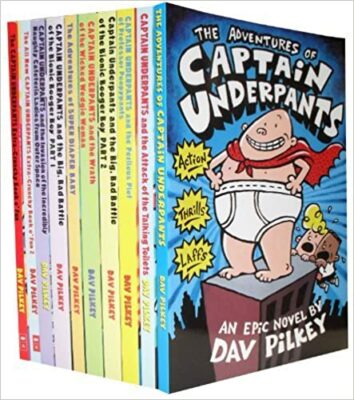
Editor’s Rating:
Quick Facts:
- Beginner’s Chapter Book Series
- Skills Required
- Spelling skills and phonetics
- Basic reading speed and fluency
- Skills Developed
- Reading speed and fluency
- Drawing connections
- Making inferences
This set collects 10 out of the 12 books in the Captain Underpants series in one (with the Tyrannical Retaliation of the Turbo Toilet 2000 and the Sensational Saga of Sir Stinks-A-Lot being sold separately) . It’s one of the most popular series used by parents and teachers to encourage children to read just for fun instead of just because they have to. The hilarious adventures that happen throughout each book will keep children reading for hours on end.
Summary
Fourth graders, George and Harold, accidentally turn their grumpy school principal into a superhero by the name of Captain Underpants when they decide to hypnotize him one day. What follows are classic superhero adventures with plenty of hilarious twists.
If your child speeds through this set, there’s two more books in the Captain Underpants saga as well as a 9-book spinoff series called Dog Man that your children are sure to enjoy just as much.
For all the fun and charm to these stories, there isn’t much of a “moral” to them. For parents who prefer books that have positive moral messages and themes, something like Zoey and Sassafras might be preferable.
Skill Focus
The simple and engaging writing style is accessible for younger children so the series makes a great stepping stone from picture books to “grown up” chapter books. Even kids who still read a little slower can use this series to build up speed. As they work through the series, they’ll gain the skills and the confidence to become avid readers.
In addition to the main novels, there are also two activity books that help further reinforce your child’s reading skills with puzzles, word finders, crosswords, and other literacy-based activities that are all inspired by the world of Captain Underpants that your child has grown to love.
Pros
- Great series for sparking a love of reading
- Helps build strong fundamental reading skills like fluency and phonetics
- Long series with spinoffs and activity books
Cons
- Lack of moral or positive messages
Final Thoughts on Books for 7-Year-Olds
The seventh year of a child’s life is an exciting time when many kids love to dive in to books of all kinds. Whether they’re a developing reader looking for a lighthearted picture book or a keen kid who wants to start their first long chapter book series, there’s a book on this list that will help them develop their skills and their love of reading even further.
